47 Brilliant Small Living Room Ideas That Make Every Square Foot Count
Your small living room doesn’t have to feel cramped or compromised.
With the right design strategies and smart choices, you can transform even the tiniest space into a stylish, functional haven that feels surprisingly spacious.
These expert-backed ideas will help you maximize every square foot while creating a room you absolutely love spending time in.
01. Stick to One Color Family
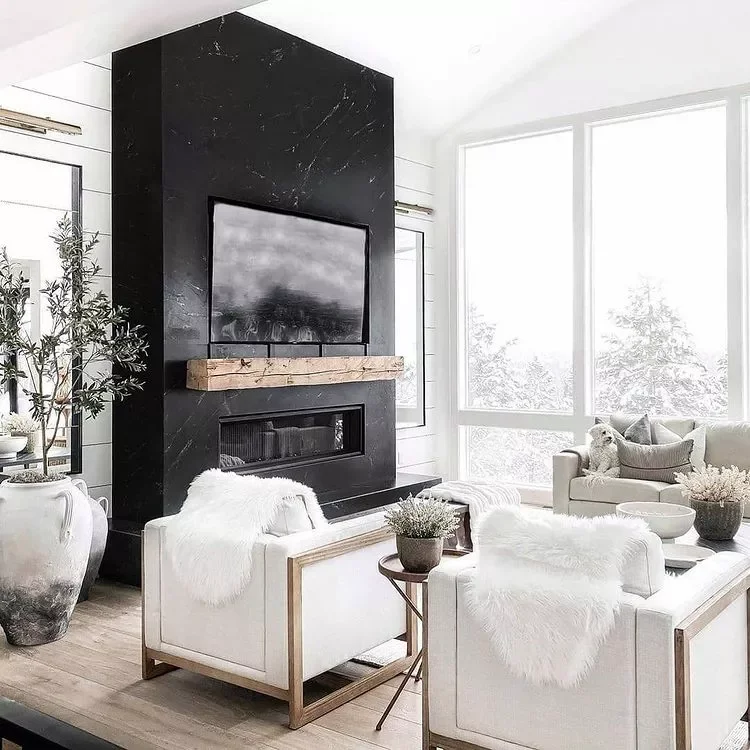
Credit: @thevisionairyhusbands / Instagram
70K+ People Bought this $29 game-changer Last Month (The Reviews Are Insane)
You’ll create incredible visual flow by keeping all your colors within the same family.
This design trick makes your space feel larger and more cohesive. Choose monochromatic tones that complement each other, then add depth through different textures and finishes instead of bold color contrasts.
02. Choose One Statement Sofa
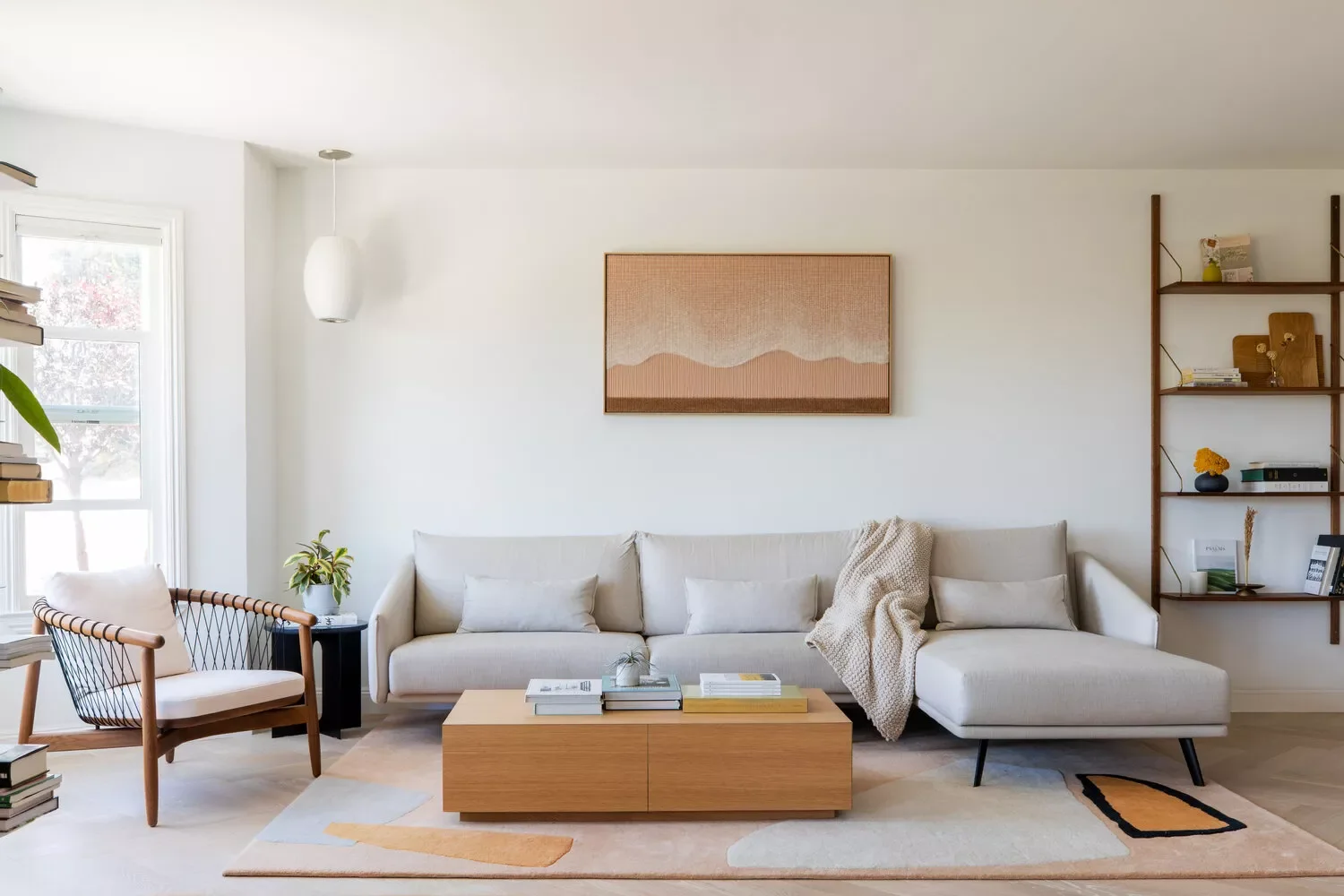
Credit: Design by Cathie Hong Interiors / Photo by Christy Q. Photo
Your best bet is selecting one gorgeous sectional that serves as your room’s anchor piece.
This approach eliminates visual clutter while providing maximum seating. Keep additional chairs minimal and sleek, focusing on quality over quantity to maintain that streamlined, sophisticated look you’re after.
03. Mix Different Light Sources
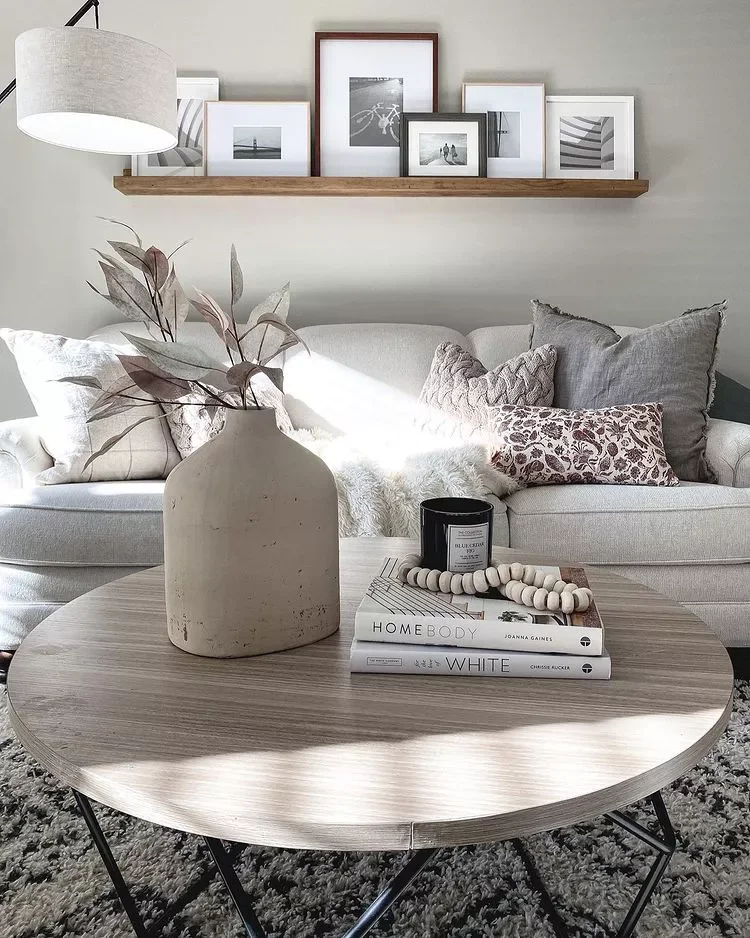
Credit: @thelasthouseonbedfordlane / Instagram
You need multiple lighting layers to make your small space feel warm and inviting.
Combine overhead pendants with dimmable controls, cozy table lamps, and strategic wall sconces. Choose fixtures that direct light both up and down to create height illusions and intimate atmosphere pools.
04. Build Around One Color
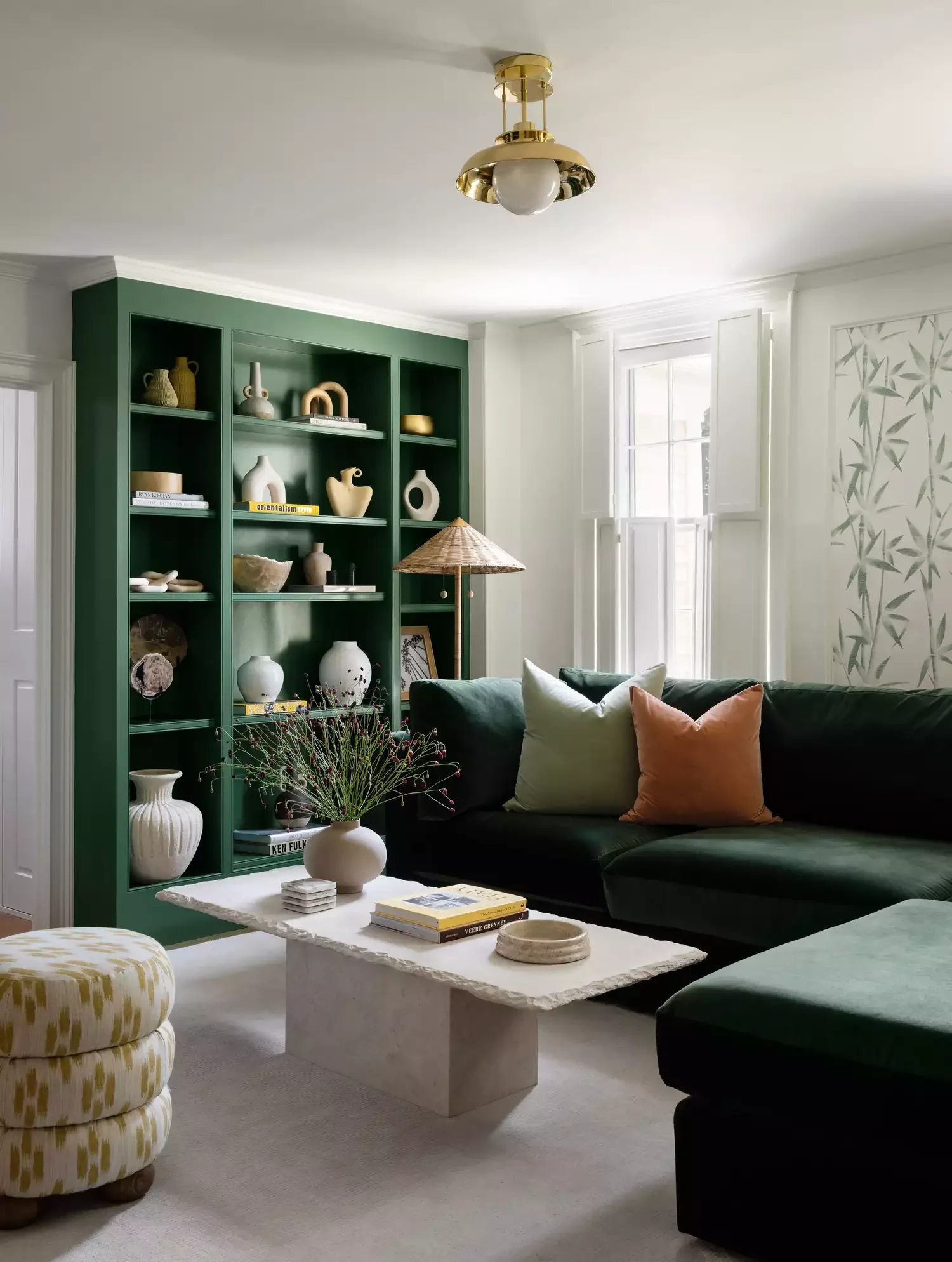
Credit: Desiree Burns Interiors
You can add incredible depth by using three different shades of the same color throughout your room.
This creates visual interest without overwhelming your space. Try incorporating your chosen color family in your sofa, wall treatments, and built-in storage for a cohesive, professionally designed look.
05. Remove Interior Walls
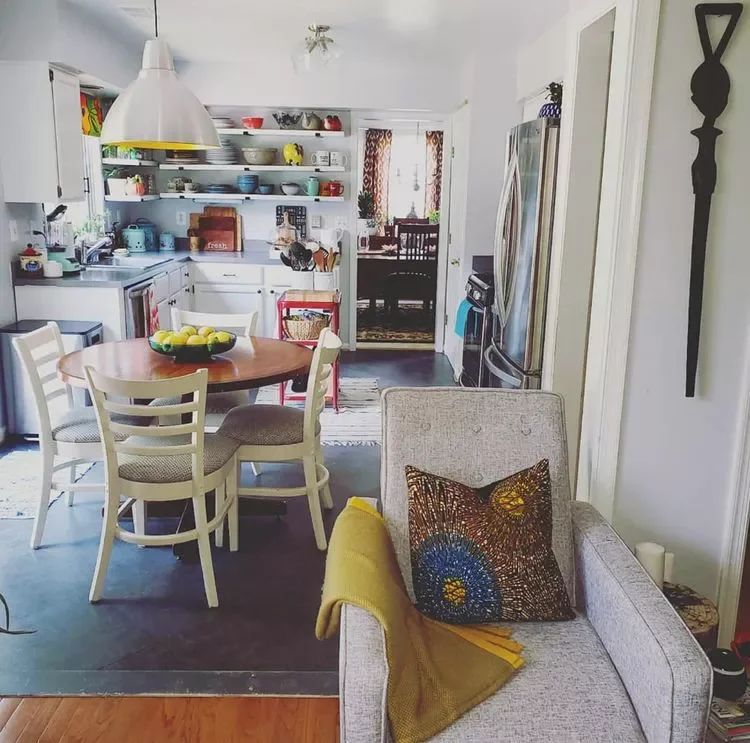
Credit: @reflektiondesign / Instagram
If you own your home, consider opening up walls to create a brighter, more expansive feeling.
This structural change allows natural light to flow freely throughout your space. Pair this with floor-to-ceiling windows and light paint colors to maximize the airy, open atmosphere you’re creating.
06. Display Smaller Art Pieces
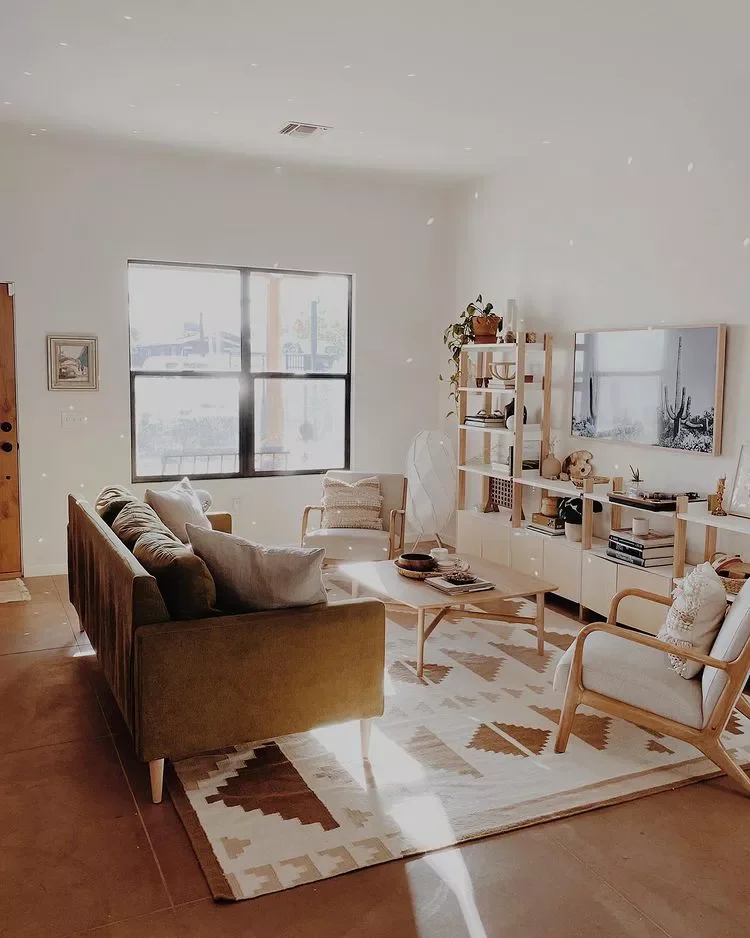
Credit: @oursouthwestnest / Instagram
You’ll make your walls breathe by choosing smaller, meaningful artwork instead of overwhelming statement pieces.
This approach allows your eye to move freely around the room, creating a sense of spaciousness. Select pieces that truly speak to you rather than filling every available wall space.
07. Invest in Double-Duty Furniture
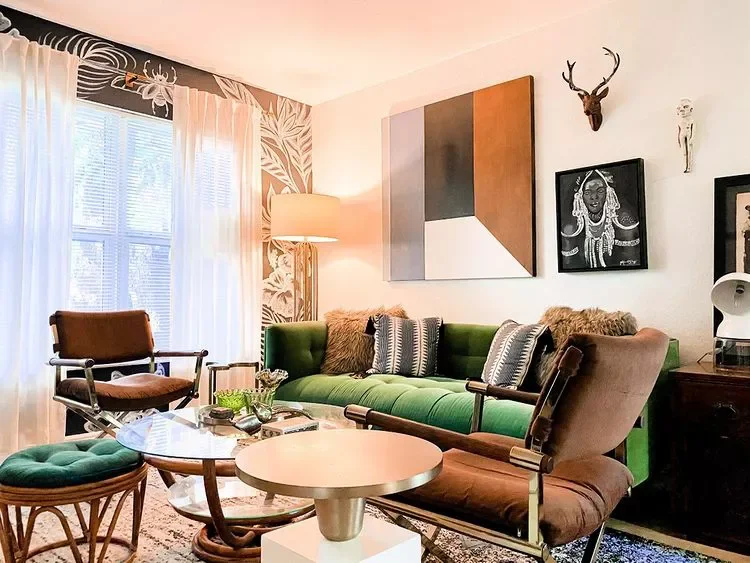
Credit: @reflektiondesign / Instagram
Your furniture should work twice as hard in a small space by serving multiple purposes.
Try upholstered ottomans that provide seating and hidden storage, or place bookshelves near windows to create cozy reading nooks. These clever solutions maximize functionality without sacrificing style or precious square footage.
08. Position Mirrors Strategically
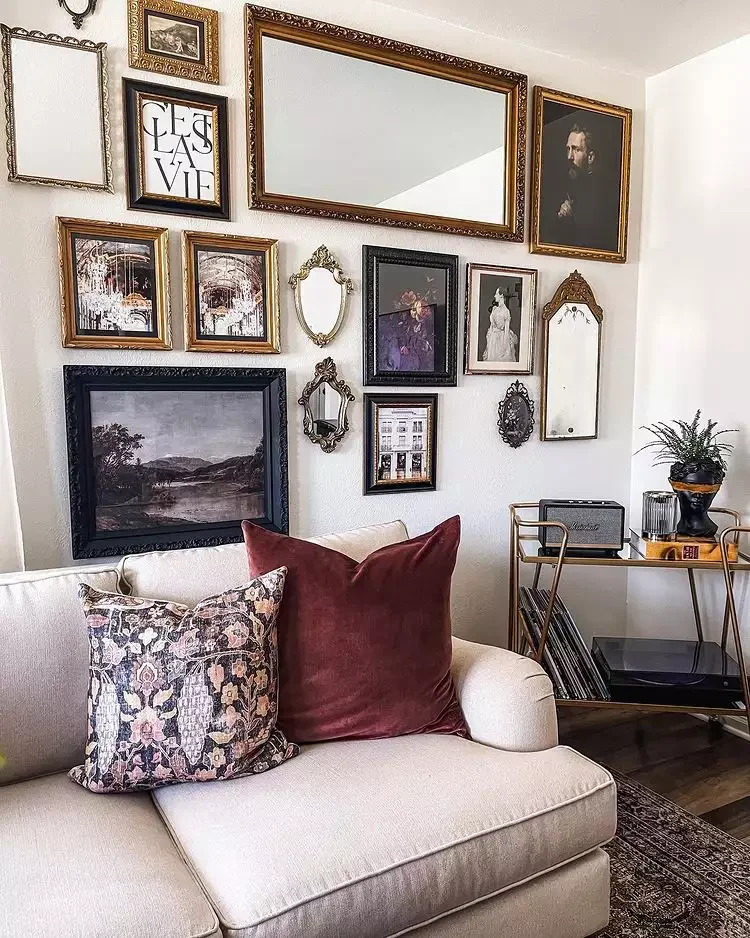
Credit: @love_in_1000_square_feet / Instagram
You’ll instantly double your visual space by adding a well-placed mirror in your living room.
Position mirrors near your entrance or opposite windows to reflect natural light throughout the room. This time-tested design trick creates an instantly brighter, more open feeling that works every single time.
09. Pair Light Walls with Dark Floors

Credit: @love_in_1000_square_feet / Instagram
You can create a clean, sophisticated look by contrasting light walls with darker flooring.
This combination adds warmth and grounding to your space while maintaining that airy feeling. The contrast helps define your room’s boundaries without making it feel closed in or cramped at all.
10. Focus Your Artwork Above the Sofa
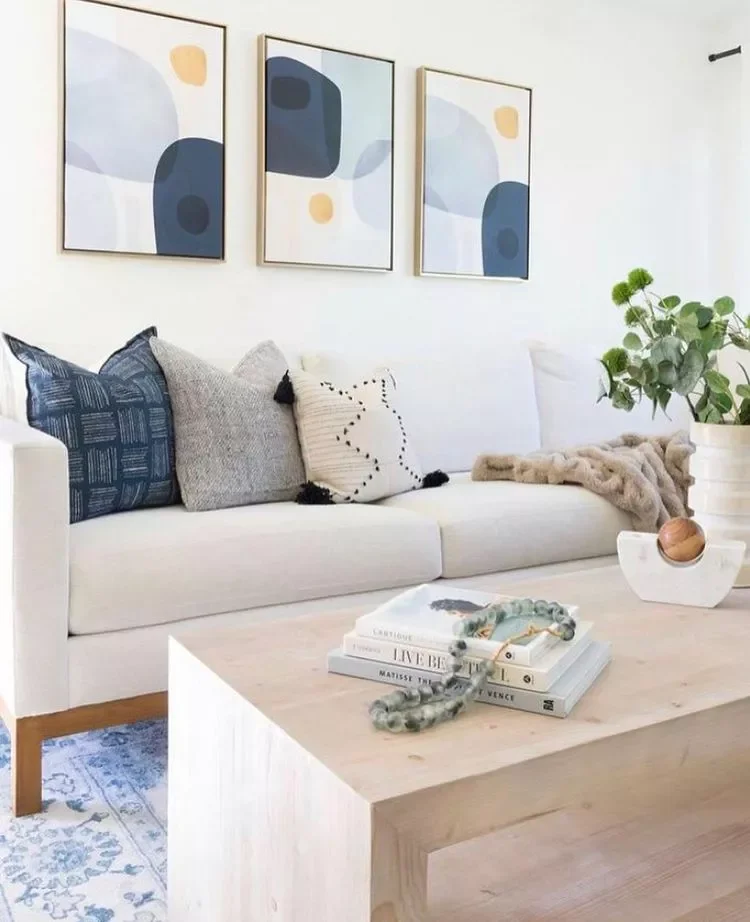
Credit: @darbywellisdesign / Instagram
You’ll avoid visual clutter by concentrating your artwork in one strategic location above your main seating.
This creates a strong focal point without overwhelming your small space. Rather than scattering art throughout the room, this approach maintains clean lines and purposeful design that feels intentional.
11. Install Stylish Wall Sconces
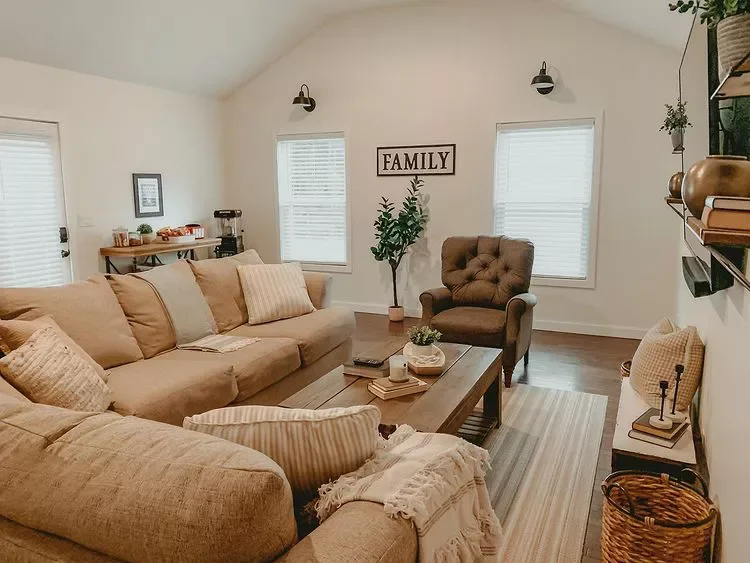
Credit: @weepingwillow.farmhouse / Instagram
You can brighten your space without taking up valuable floor or table space with wall-mounted lighting.
Group sconces together for dramatic impact, or position them flanking windows for a gallery-inspired look. This lighting solution adds sophistication while keeping your surfaces clear and uncluttered.
12. Rotate Your Decorative Items
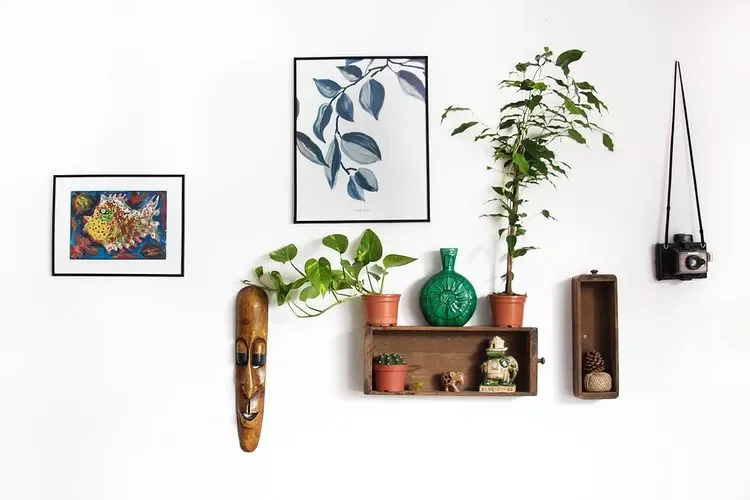
Credit: @reflektiondesign / Instagram
You’ll keep your space feeling fresh and interesting by regularly moving decorative pieces to different locations.
This simple strategy prevents visual stagnation while allowing your favorite items to shine in new contexts. It’s an easy way to refresh your room’s look without spending money on new pieces.
13. Add Elegant Vases
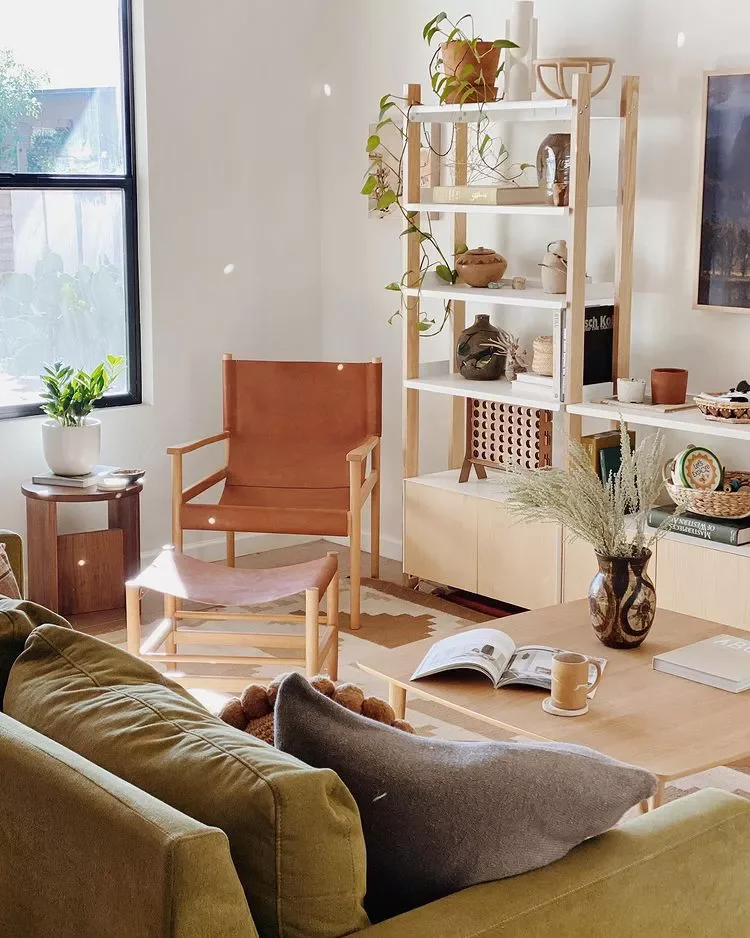
Credit: @oursouthwestnest / Instagram
You can introduce visual interest without creating clutter by incorporating sleek glass or porcelain vases.
Choose tall, clean-lined pieces that add height and elegance to your space. These simple accessories provide sophisticated focal points while maintaining the uncluttered aesthetic essential for small room success.
14. Make the Most of Built-In Nooks

Credit: @darbywallisdesign / Instagram
You should take full advantage of any recessed spaces or alcoves by turning them into functional seating areas.
Nestle a smaller sofa or create a cozy reading nook in these natural indentations. This approach maximizes every inch of your floor plan while creating charming, intimate spaces within your room.
15. Camouflage Your Television
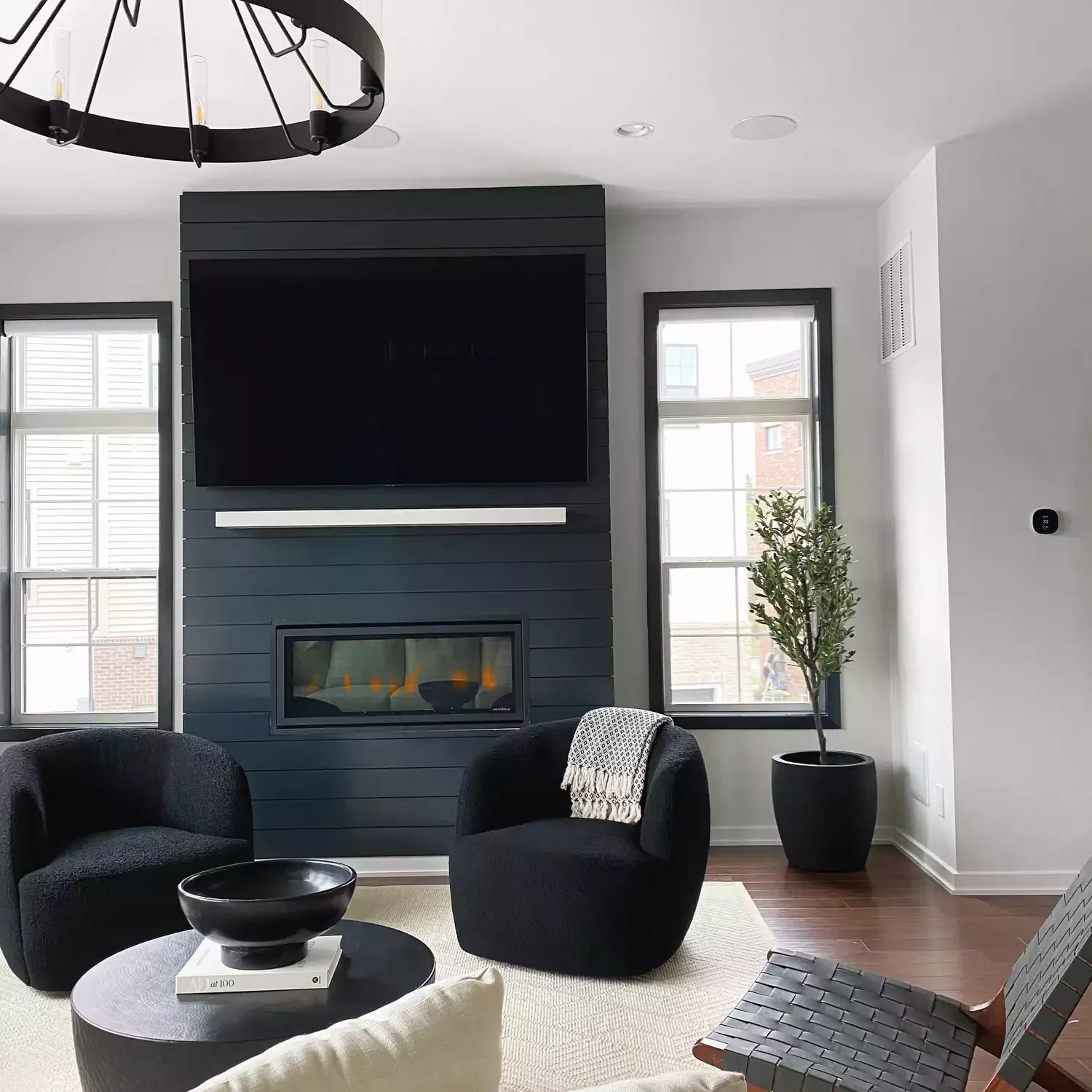
Credit: Brexton Cole Interiors
You can minimize your TV’s visual impact by painting the wall behind it in a dark, rich color.
This clever trick helps large screens blend into the background rather than dominating your space. Consider mounting it above a fireplace or incorporating it into a built-in entertainment center for seamless integration.
16. Add Open Display Shelving
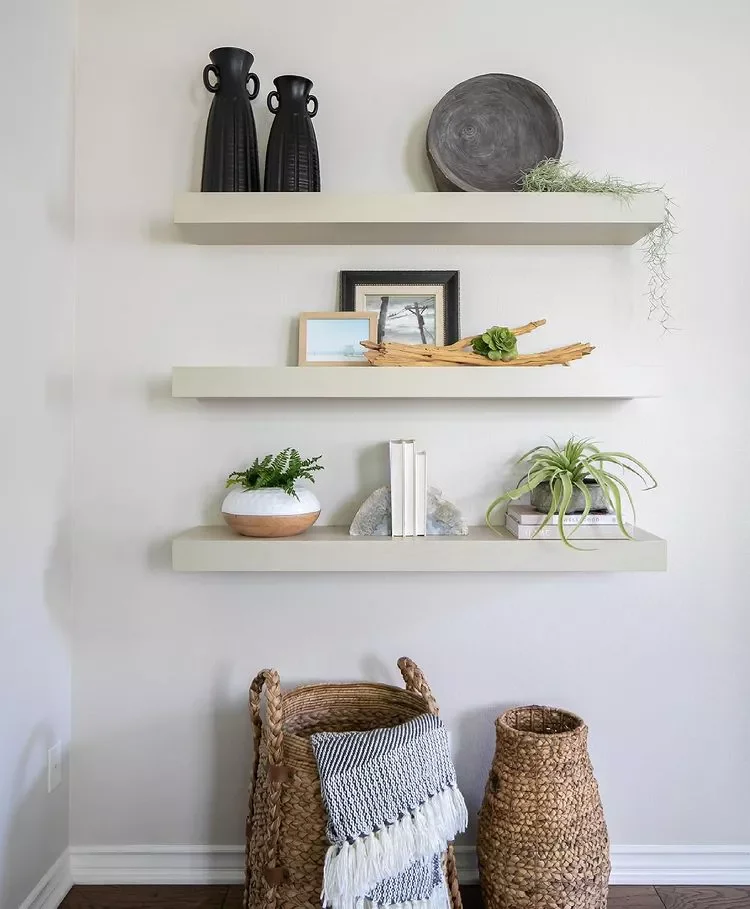
Credit: @darbywallisdesign / Instagram
You’ll create functional storage that doesn’t overwhelm your space with carefully styled open shelving.
Keep displays tidy and purposeful, mixing books with decorative objects and plants. This approach provides necessary storage while maintaining the open, airy feeling that makes small spaces feel larger and more inviting.
17. Paint Everything in Neutral Tones
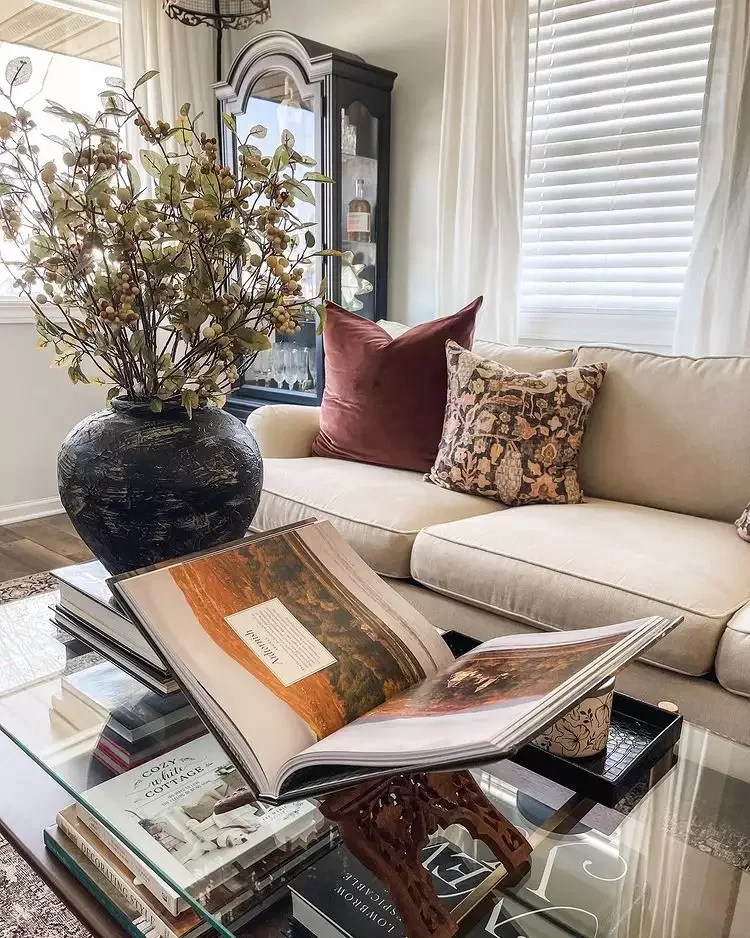
Credit: @love_in_1000_square_feet / Instagram
You’ll instantly expand your visual space by painting walls in a single, light neutral shade.
This creates a cohesive backdrop that makes rooms feel larger and more serene. Add personality through colorful furniture pieces, artwork, and accessories that can easily change with your evolving style preferences.
18. Play with Furniture Heights

Credit: @thecollectivedallas / Instagram
You can add visual dimension by mixing furniture pieces of varying heights and depths throughout your room.
A low-profile sofa will make your ceilings appear taller, while different furniture levels create interesting sight lines. This strategy prevents your space from feeling flat or monotonous while maintaining good flow.
19. Choose Light-Colored Rugs
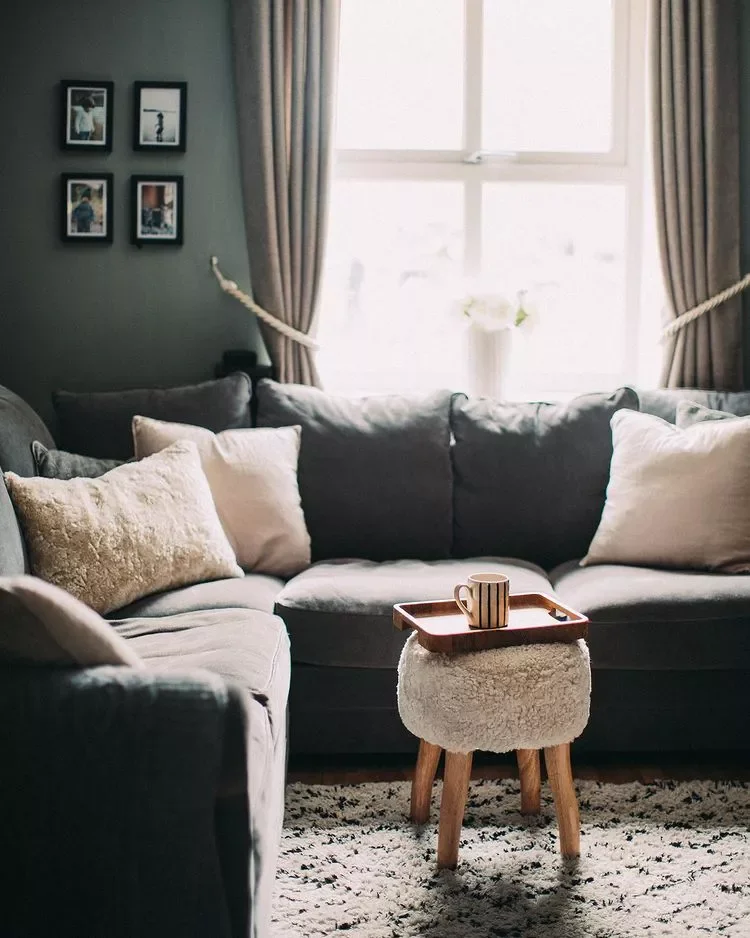
Credit: @little_weavers_cottage / Instagram
You’ll maximize your space’s brightness and openness by selecting rugs in neutral, light colorways.
Light-colored textiles reflect more light and create an airy atmosphere that makes rooms feel significantly larger. Avoid dark or heavily patterned rugs that can visually shrink your already limited square footage.
20. Think Vertically for Storage
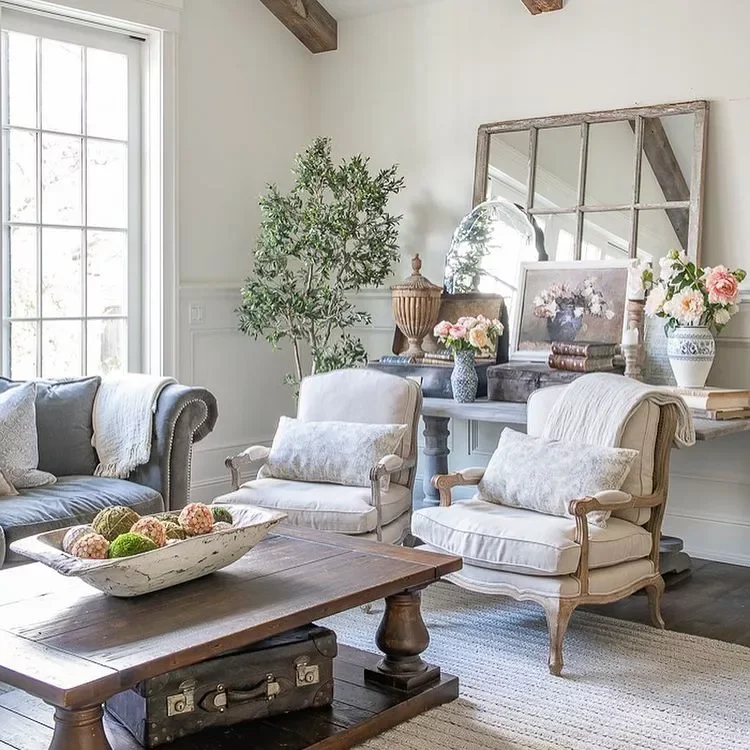
Credit: @sanctuaryhomedecor / Instagram
You should focus on wall-mounted storage solutions that keep your floor space completely clear and usable.
Hanging cabinets and floating shelves provide necessary storage without consuming precious square footage. This vertical approach allows you to use floor space for furniture and movement while maintaining organized, clutter-free surfaces.
21. Embrace Minimalist Design
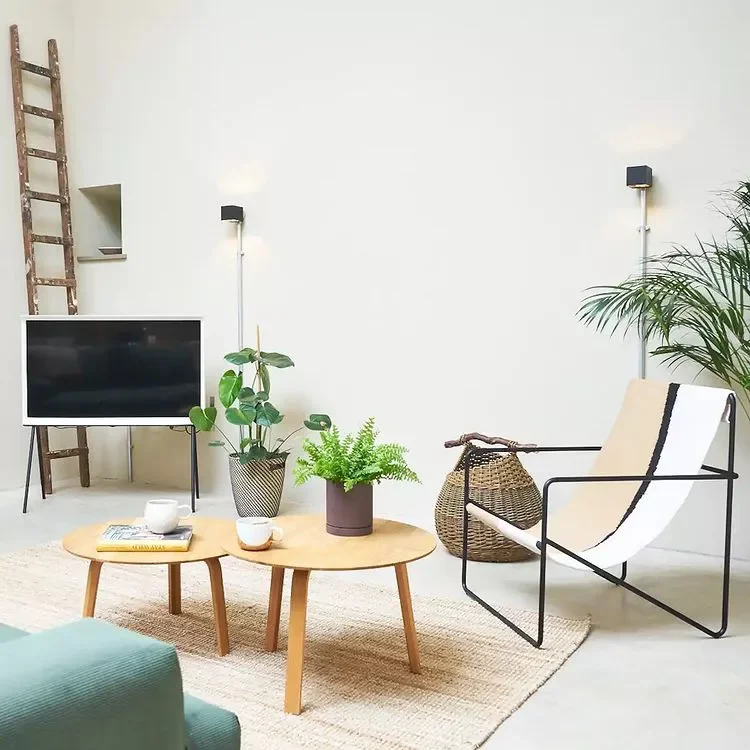
Credit: @sorenshome / Instagram
You’ll create a light, airy atmosphere by adopting a minimalist approach with carefully chosen multifunctional pieces.
Focus on quality over quantity, selecting furniture that serves multiple purposes. Mix and match thoughtfully to create a cohesive look that feels intentional rather than sparse or incomplete.
22. Incorporate Reflective Surfaces
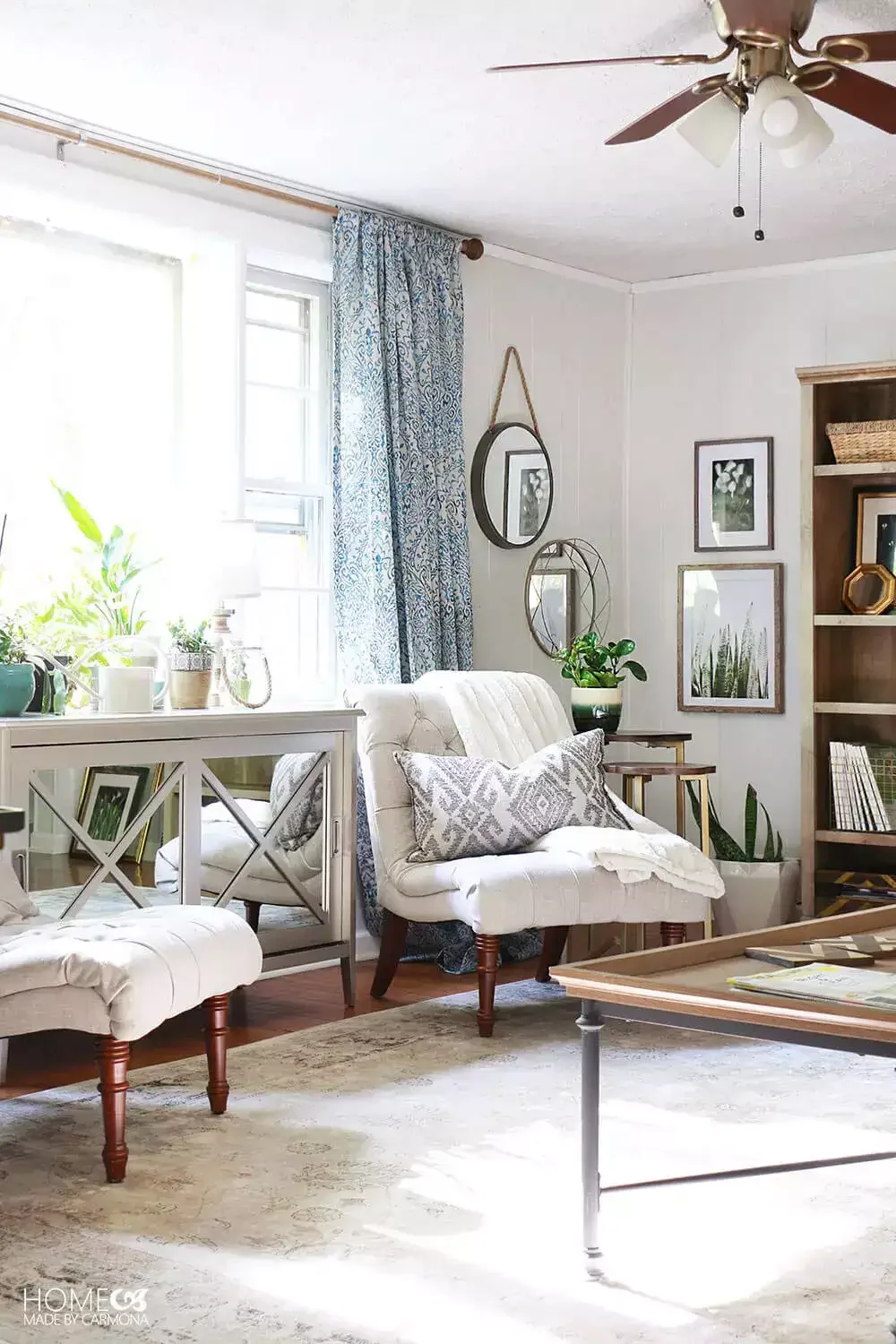
Credit: Ursula Carmona of Home Made By Carmona
You can expand your space visually by incorporating mirrored furniture pieces that bounce light around the room.
Mirrored buffets, side tables, or decorative accessories reflect views and create the illusion of expanded square footage. These pieces work especially well in darker corners where they can brighten and open up the space.
23. Celebrate Unique Architectural Features
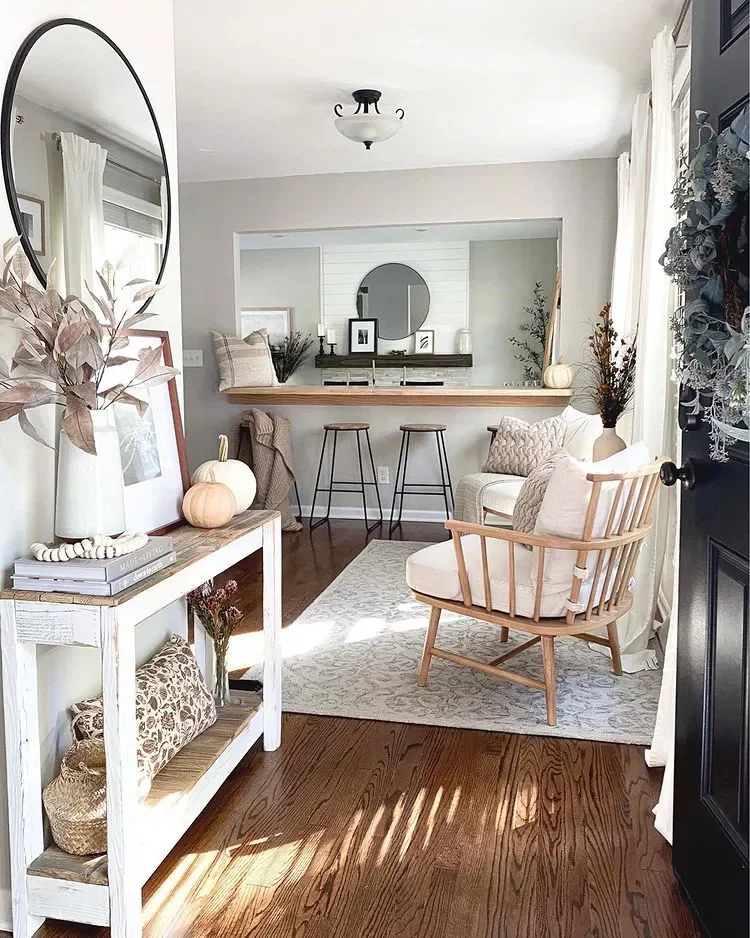
Credit: @lasthouseonbedfordlane / Instagram
You should embrace awkward angles and unusual layouts as opportunities to create character rather than viewing them as problems.
Use salon-style gallery walls or jewel-box decorating approaches to highlight your space’s unique personality. These quirky features can become your room’s most charming and memorable elements.
24. Maximize Natural Light Sources
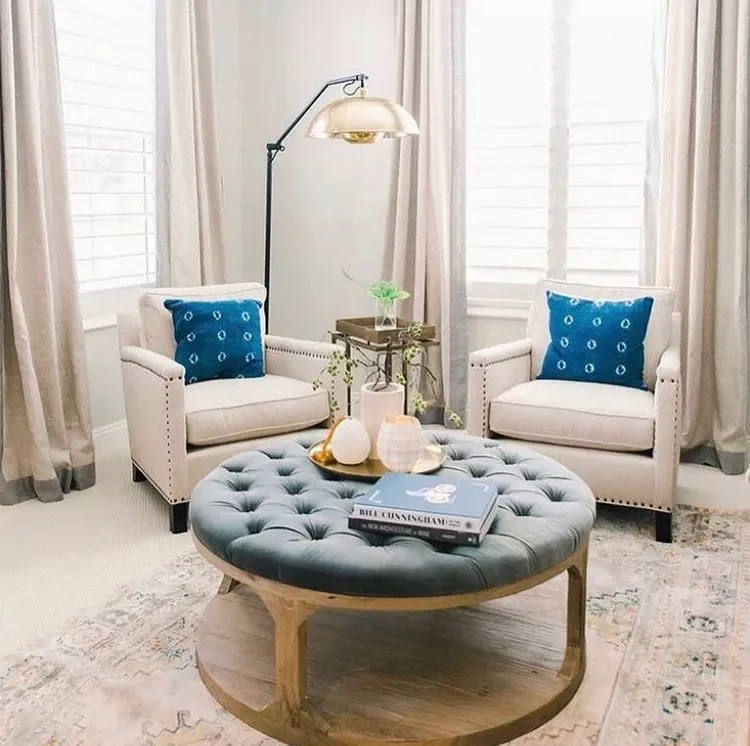
Credit: @darbywallisdesign / Instagram
You’ll make your space feel dramatically larger by optimizing every source of natural light available.
Use sheer curtains, keep window sills clear, and clean windows regularly to maximize brightness. Strategic mirror placement and light paint colors will help bounce that precious natural light throughout your entire room.
25. Use Light Color Palettes

Credit: @weepingwillow.farmhouse / Instagram
You can dramatically increase your room’s perceived size by choosing colors with high light reflectance like whites and pale tones.
These colors bounce light around your space rather than absorbing it, creating an instantly brighter, more expansive feeling. This fundamental design principle works especially well in rooms with limited natural light.
26. Skip Bold Pattern Rugs
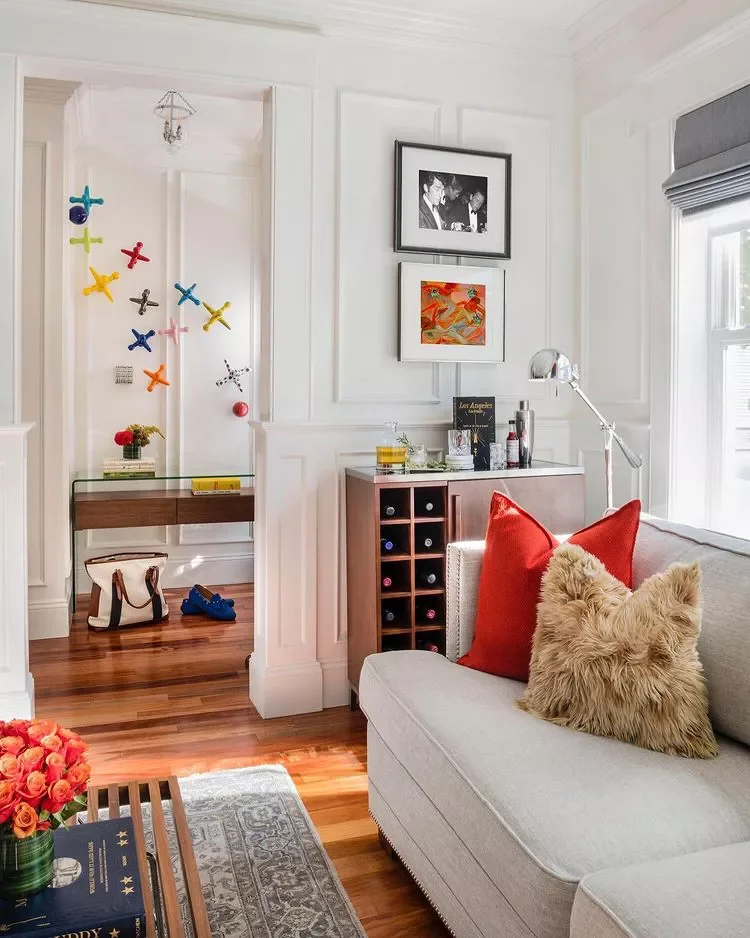
Credit: @trevorfulmerdesign / Instagram
You should avoid statement rugs that create strong focal points, which can visually shrink your room’s perceived size.
Instead, choose uniform, subtle patterns that blend seamlessly with your overall design scheme. This approach prevents any single element from drawing too much attention and fragmenting your carefully planned visual flow.
27. Place Mirrors for Maximum Impact
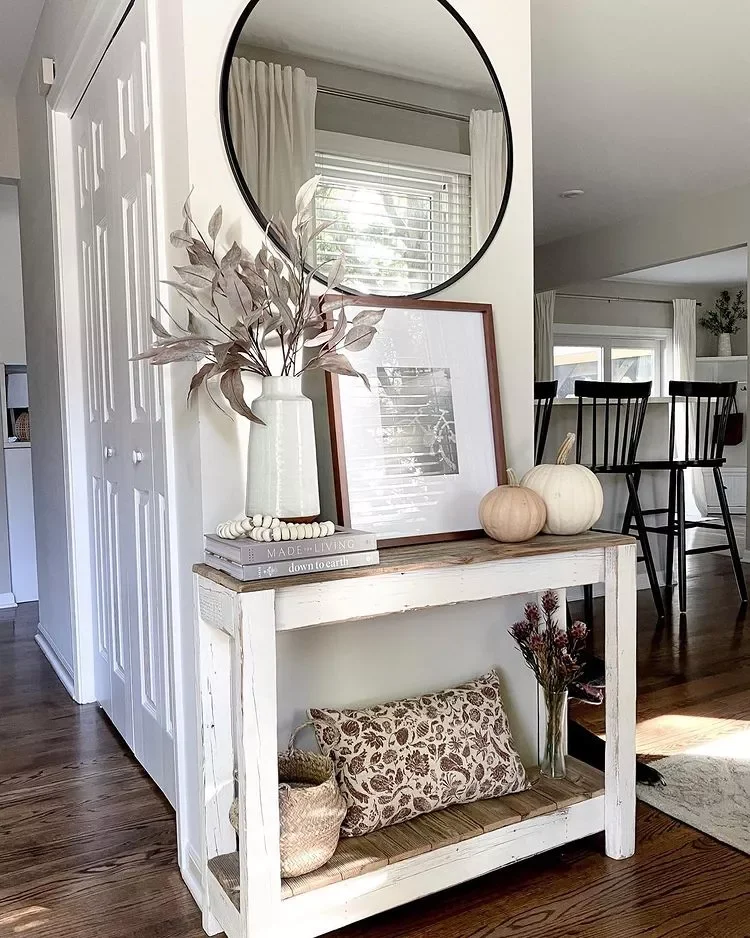
Credit: @lasthouseonbedfordlane / Instagram
You’ll double your visual space by positioning mirrors opposite windows to reflect natural light and outdoor views.
For even more dramatic effects, hang mirrors facing each other on opposite walls to create an infinity effect. This optical illusion tricks the eye into perceiving much more space than actually exists.
28. Select Furniture with Visible Legs
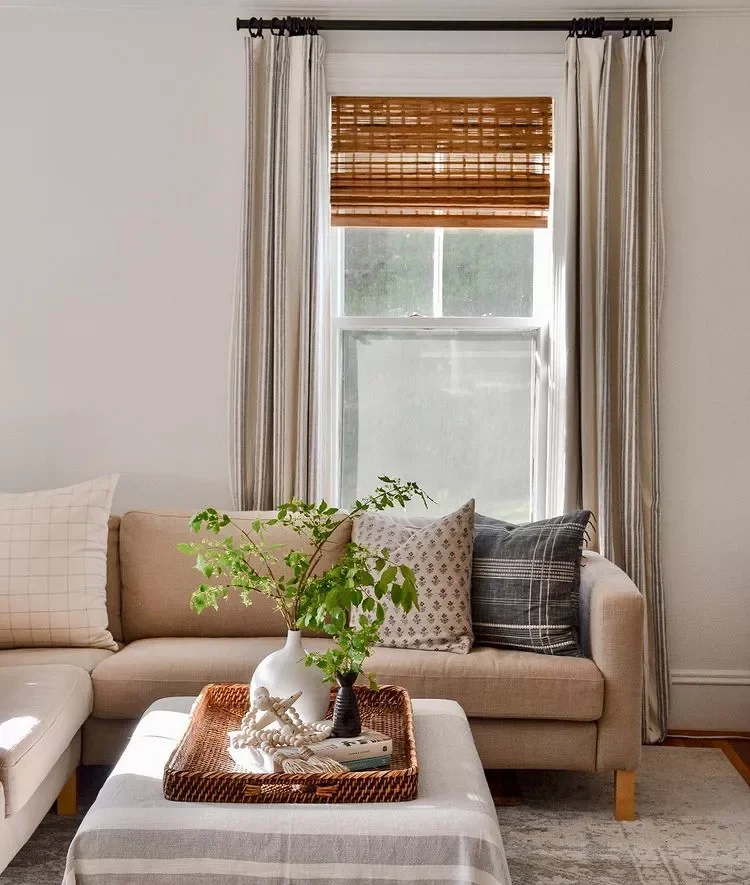
Credit: @flynnhaus / Instagram
You can create more visual breathing room by choosing sofas, chairs, and tables that are elevated off the ground.
When you can see floor space underneath furniture, your eye perceives the room as larger and less cluttered. This simple trick works because continuous sight lines make spaces feel more open and expansive.
29. Try Warm Beige Tones
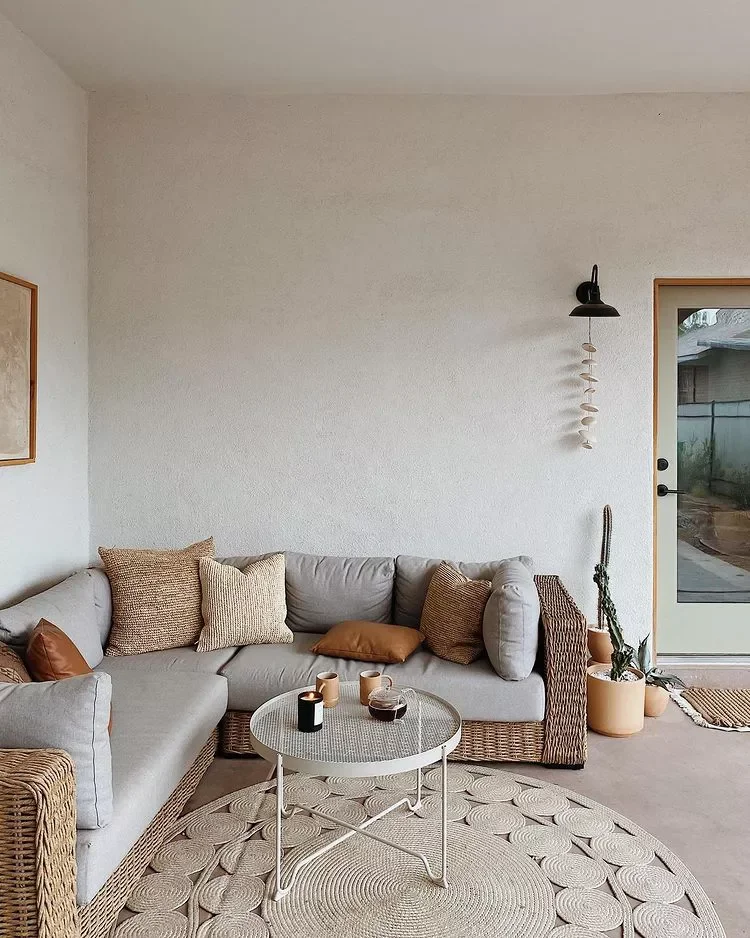
Credit: @oursouthwestnest / Instagram
You don’t have to stick with stark white to achieve a spacious feeling in your small living room.
Light beige and taupe paint colors also reflect light beautifully while adding warmth and sophistication. These neutral tones create a cozy yet open atmosphere that feels more inviting than pure white schemes.
30. Leave Strategic Empty Space
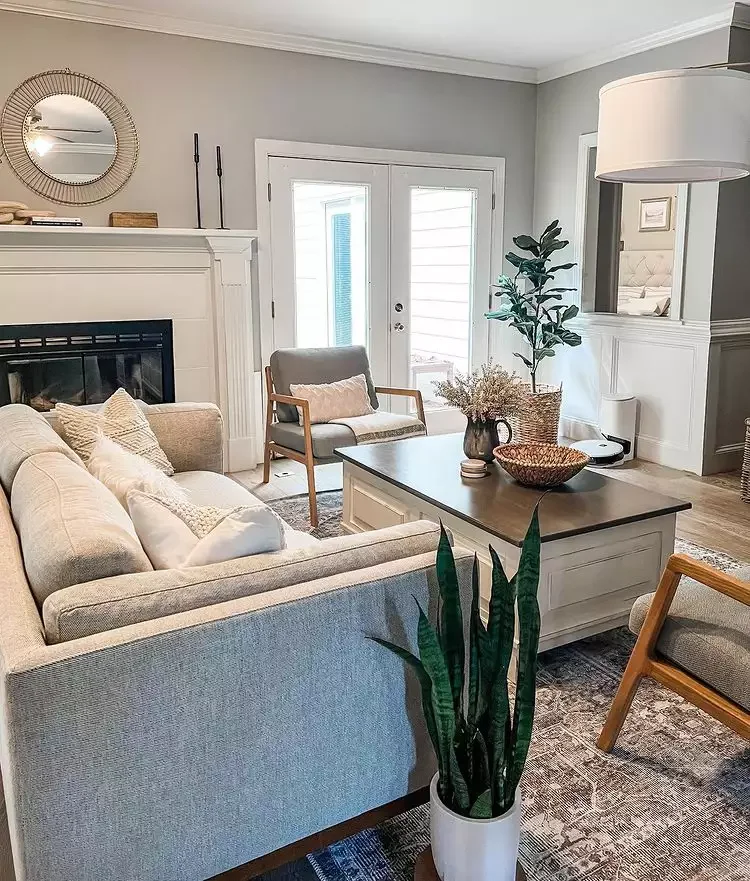
Credit: @revealmydiy / Instagram
You need to resist the temptation to fill every square inch and instead maintain purposeful negative space.
Strategic empty areas allow your room to breathe and create visual rest for the eye. This balance between furnished and unfurnished space is crucial for achieving a comfortable, high-functioning design that feels spacious.
31. Use Modular Storage Systems
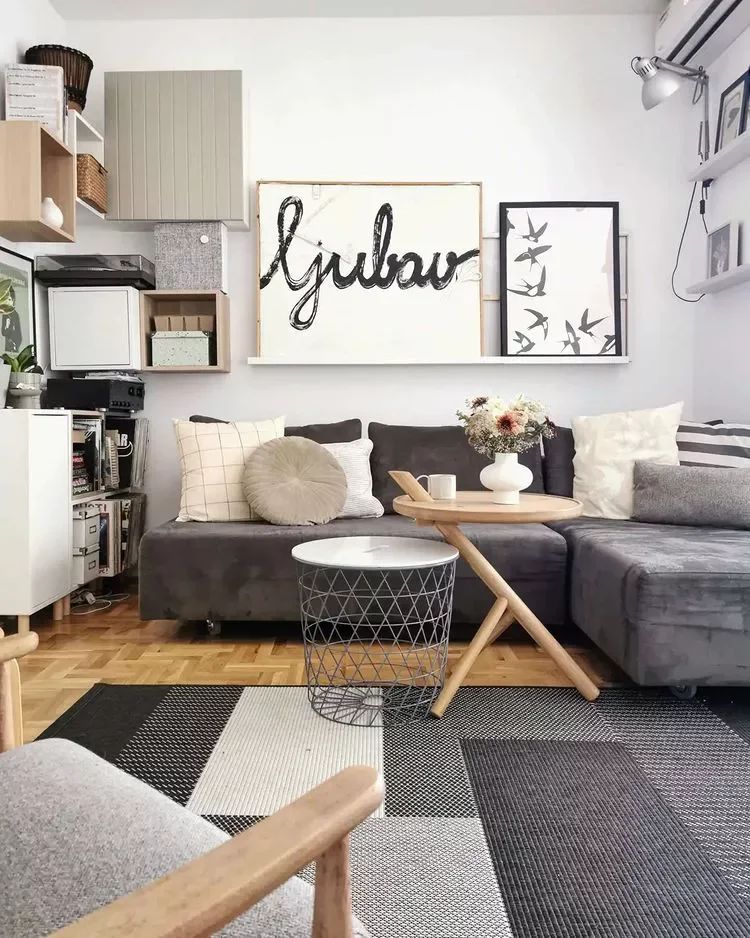
Credit: @masha_kindjer / Instagram
You’ll maximize storage while minimizing floor space consumption by installing modular cabinet systems along entire walls.
These shallow units, typically only 15-18 inches deep, provide enormous storage capacity without overwhelming your room. The streamlined appearance helps maintain clean lines while concealing all your necessary items and clutter.
32. Establish a Clear Focal Point
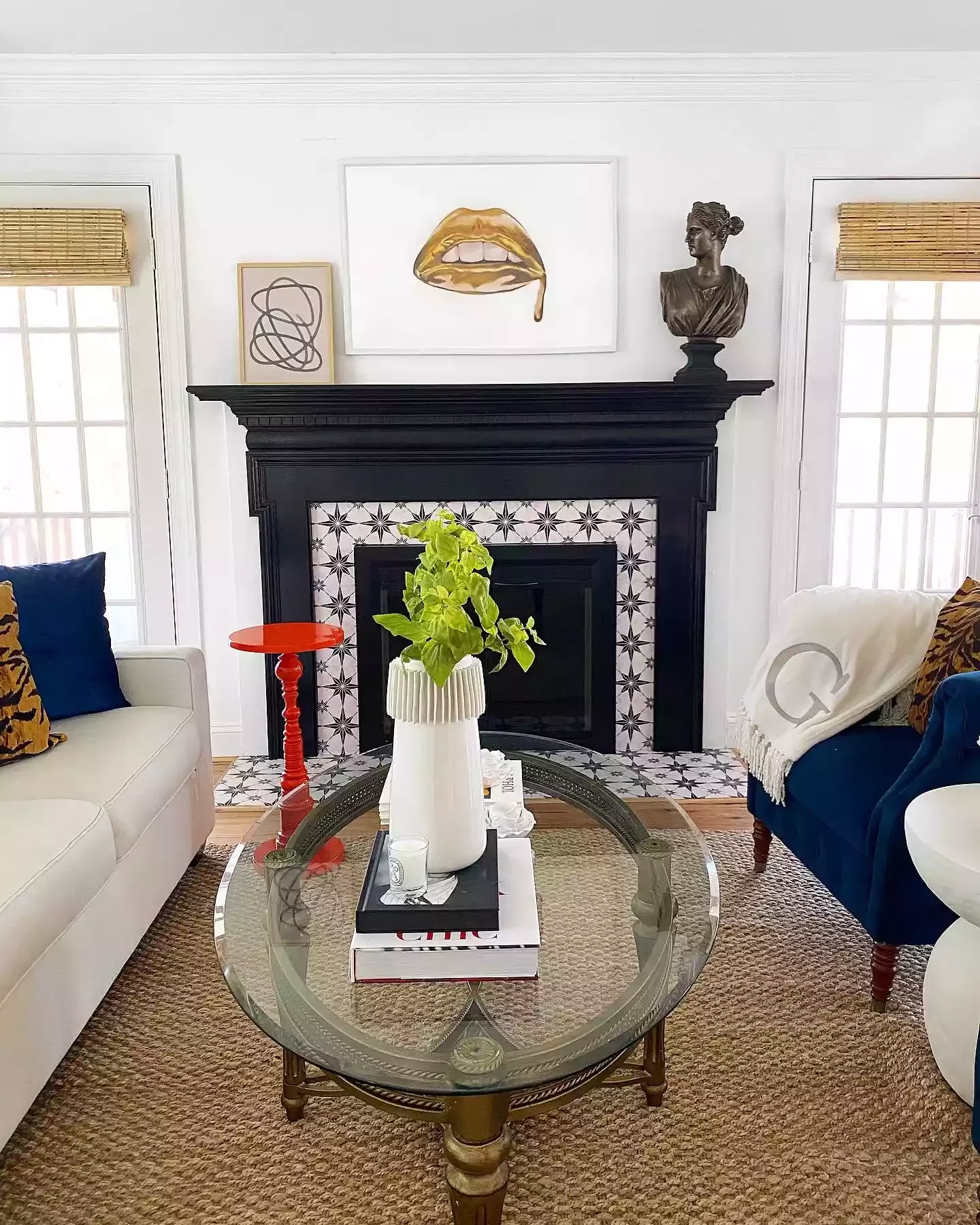
Credit: Brexton Cole Interiors
You can create a timeless furniture layout by identifying and enhancing your room’s natural focal point.
Whether it’s a fireplace, large window, or architectural feature, build your furniture arrangement around this central element. This approach creates purposeful design flow and prevents your small space from feeling scattered or unfocused.
33. Choose Low-Profile Seating

Credit: @homesweetlakehouse / Instagram
You’ll make your ceilings appear much higher by selecting low-slung sofas and seating options.
This visual trick creates more open space above your furniture line, making the entire room feel more expansive. Low furniture profiles work especially well in rooms with standard ceiling heights or smaller proportions.
34. Layer Multiple Textures
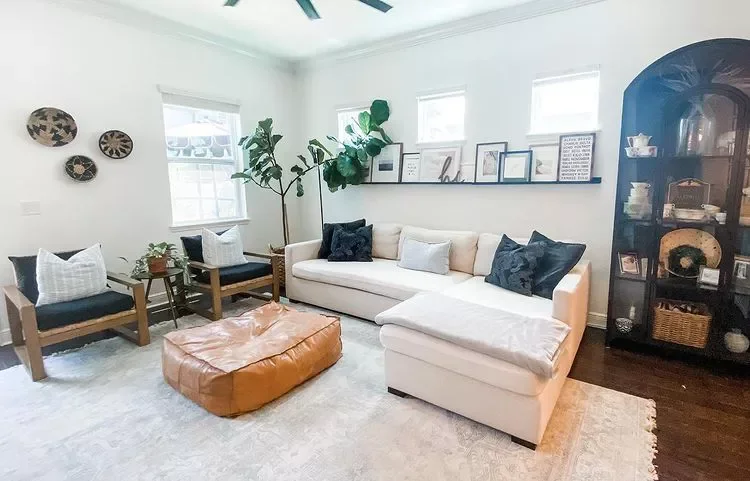
Credit: @itshomeyall / Instagram
You can keep neutral spaces visually interesting by incorporating multiple textures through textiles, materials, and finishes.
Mix smooth and rough surfaces, soft and hard materials, and matte and glossy finishes to create depth. This approach adds sophistication and warmth without relying on bold colors or busy patterns.
35. Stick to Cool Color Temperatures
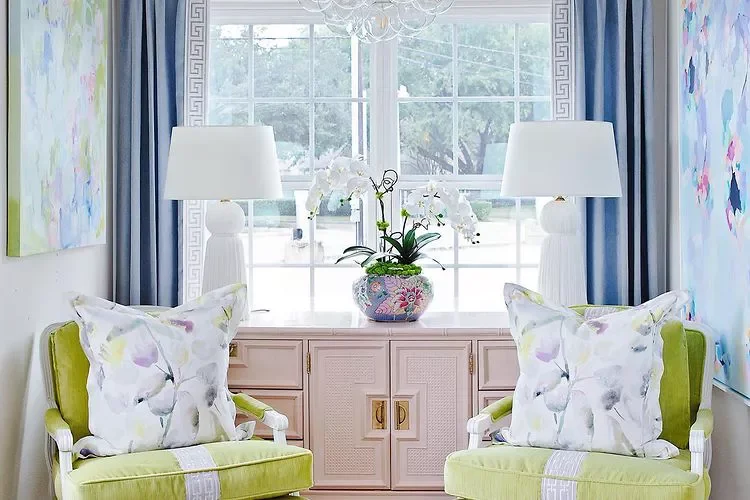
Credit: @thecollectivedallas / Instagram
You’ll prevent your small space from feeling congested by choosing cool color temperatures over warm, advancing hues.
Cool blues, greens, and grays naturally recede, making walls appear farther away. These classic colors also create better flow throughout your entire room while maintaining a serene, spacious atmosphere.
36. Create Monochromatic Schemes
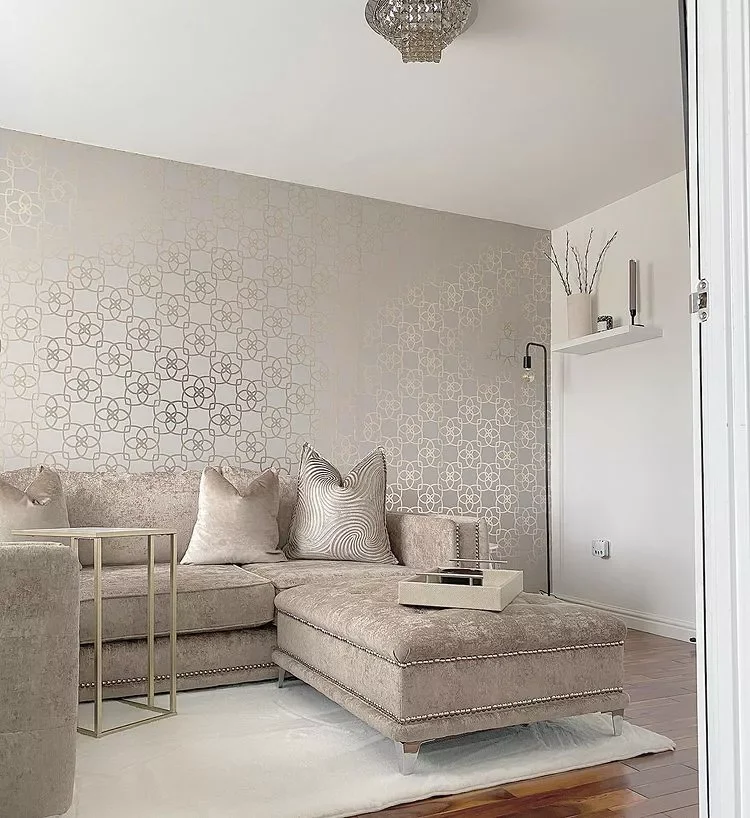
Credit: @our_little_brodick_ / Instagram
You can achieve a cohesive, expansive look by decorating with a single color in various shades and tones.
Using multiple colors tends to divide rooms visually, making them appear smaller and more fragmented. Limit yourself to one or two colors maximum for the most space-expanding, professionally designed appearance.
37. Try Classic Black and White
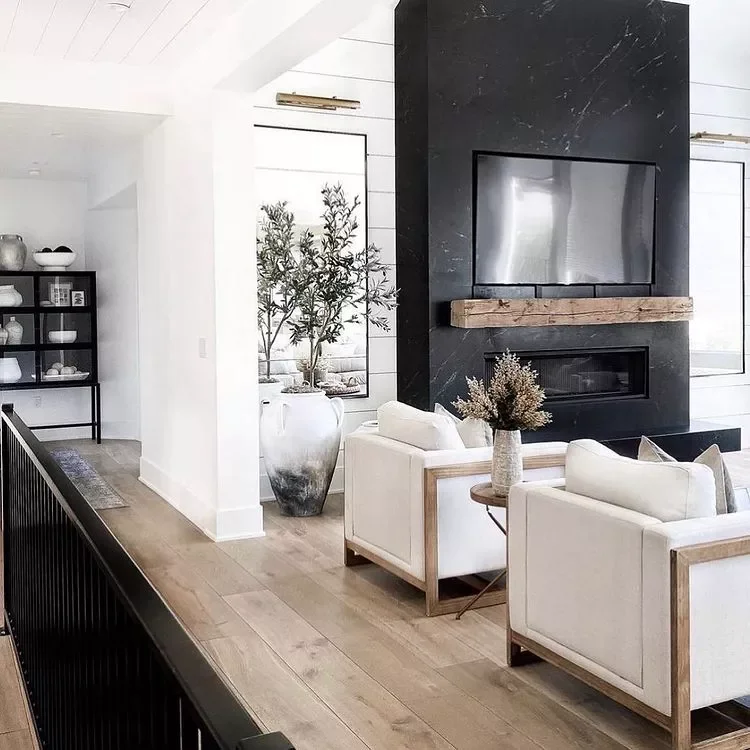
Credit: @darbywallisdesign / Instagram
You’ll create a polished, modern aesthetic with a timeless black and white color palette that never goes out of style.
Add warmth through natural wood accents and fresh greenery to prevent the scheme from feeling too stark. This high-contrast approach works beautifully in small spaces because it creates clear, defined lines.
38. Direct Eyes Toward the Ceiling
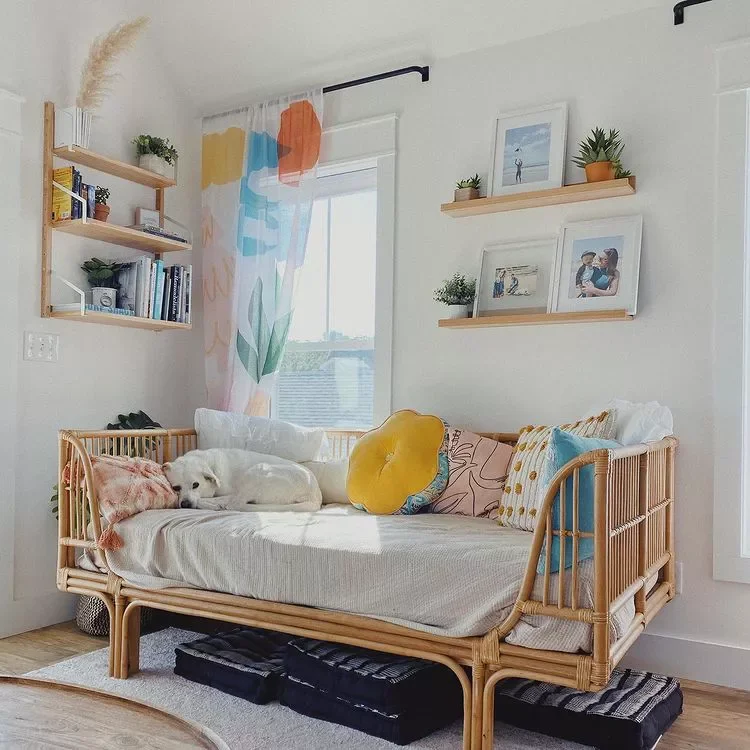
Credit: @thenewsmallhouse / Instagram
You can make ceilings appear higher by installing tall shelving, floor-to-ceiling cabinetry, or statement lighting fixtures.
Decorative chandeliers and pendant lights naturally draw the eye upward, creating a sense of vertical space. This technique works especially well in rooms where you want to emphasize height over width.
39. Go All-White for Maximum Impact
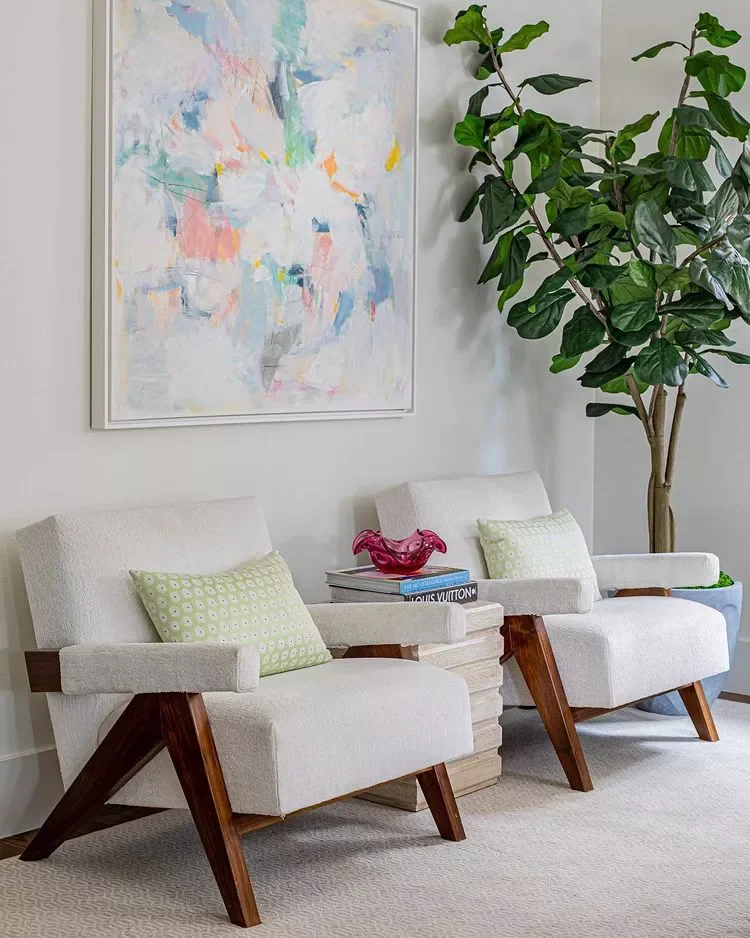
Credit: @thecollectivedallas / Instagram
You’ll achieve the most dramatic space-expanding effect with an all-white palette that reflects maximum light.
White walls, furniture, and accessories create a clean, modern look that makes even tiny rooms feel bright and airy. This approach works particularly well in spaces with abundant natural light to prevent starkness.
40. Ditch Heavy Window Treatments
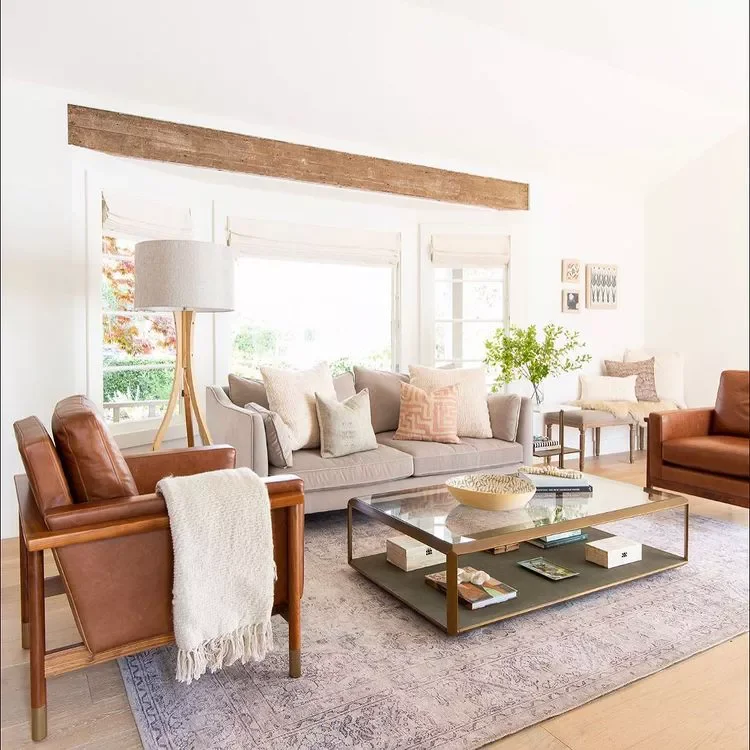
Credit: @darbywallisdesign / Instagram
You should replace heavy drapes and curtains with sleek blinds or roller shades that don’t obstruct your view.
Heavy window treatments can make small spaces feel closed off and claustrophobic. Lighter alternatives maintain privacy while allowing maximum natural light to flow freely throughout your room, creating openness.
41. Create Budget-Friendly Built-In Looks
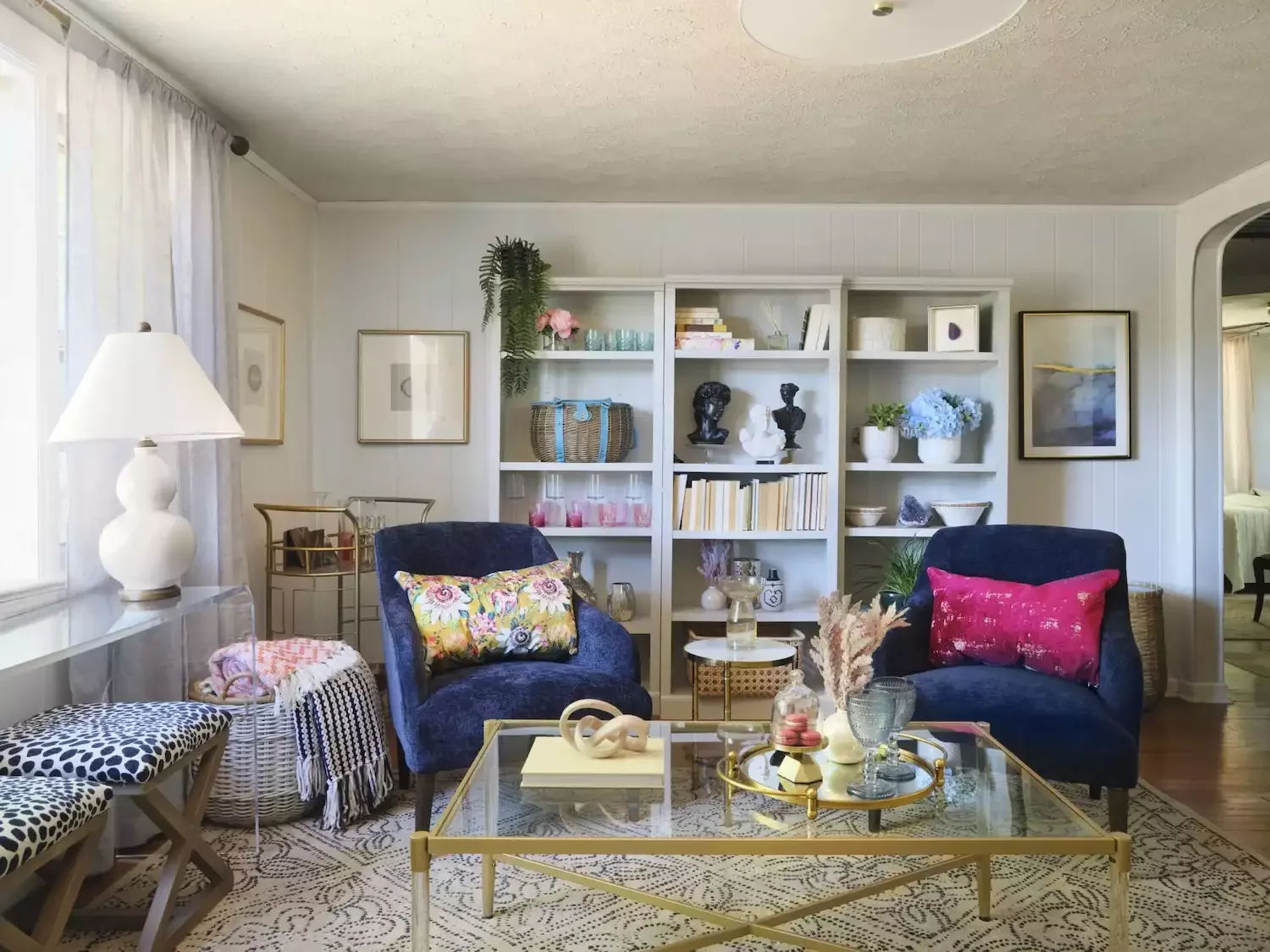
Credit: Ursula Carmona of Home Made By Carmona
You can achieve the streamlined look of custom built-ins by arranging a row of matching bookcases along one wall.
This budget-friendly approach provides excellent storage and display space while maintaining clean lines. Focus your decorative efforts on this single wall for maximum impact without overwhelming your small space.
42. Select Tables with Delicate Bases
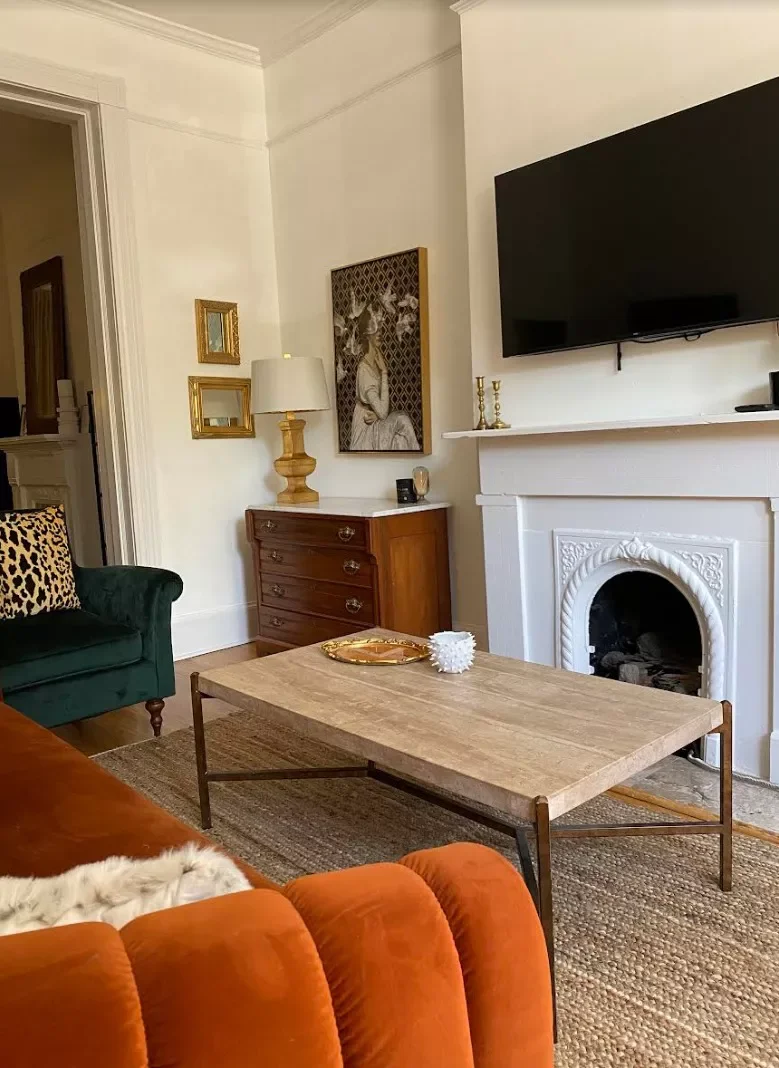
Credit: Brexton Cole Interiors
You’ll create visual lightness by choosing coffee tables with slender legs or transparent acrylic materials.
These pieces allow light to flow through and around them, maintaining an airy feeling in your space. Solid wood tops with delicate bases offer the perfect balance of functionality and visual breathing room.
43. Style a Functional Bar Cart

Credit: Forbes + Masters
You can maximize both storage and style by incorporating a well-styled bar cart in your small living room.
Load it with bottles, glassware, plants, and decorative objects for a sophisticated look. Add mirrors above for intentional design impact while creating a functional entertaining station that doesn’t require permanent space.
44. Mix Vibrant Colors and Patterns

Credit: Studio Peake
You don’t always have to stick with neutrals – sometimes bold color combinations can energize a small space beautifully.
Layer vibrant wallpaper with geometric mirrors and multicolored artwork for an eclectic, personality-filled approach. This strategy works when you want your small space to feel cozy and intimate rather than expansive.
45. Brighten with Cheerful Yellow
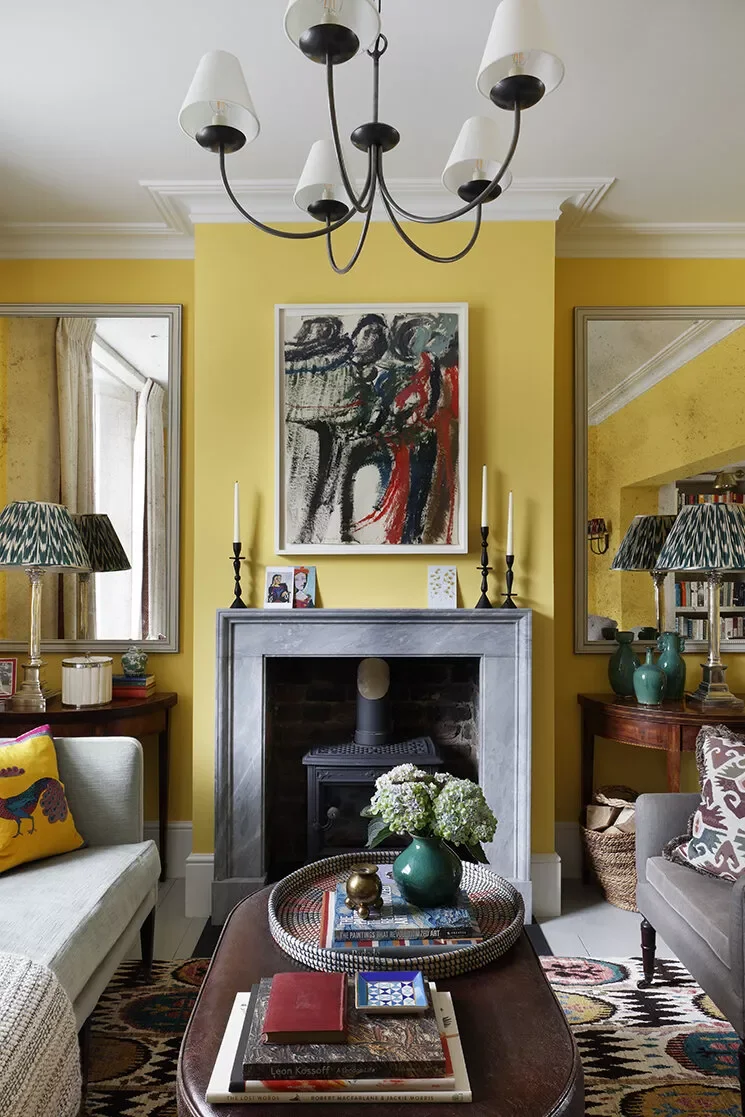
Credit: Studio Peake
You can wake up a small living room with bold yellow paint that instantly creates energy and warmth.
Complement this vibrant backdrop with red and green accents plus patterned textiles for a lively, welcoming atmosphere. This approach works well when you want your space to feel cozy rather than merely large.
46. Try Unique Vertical Storage
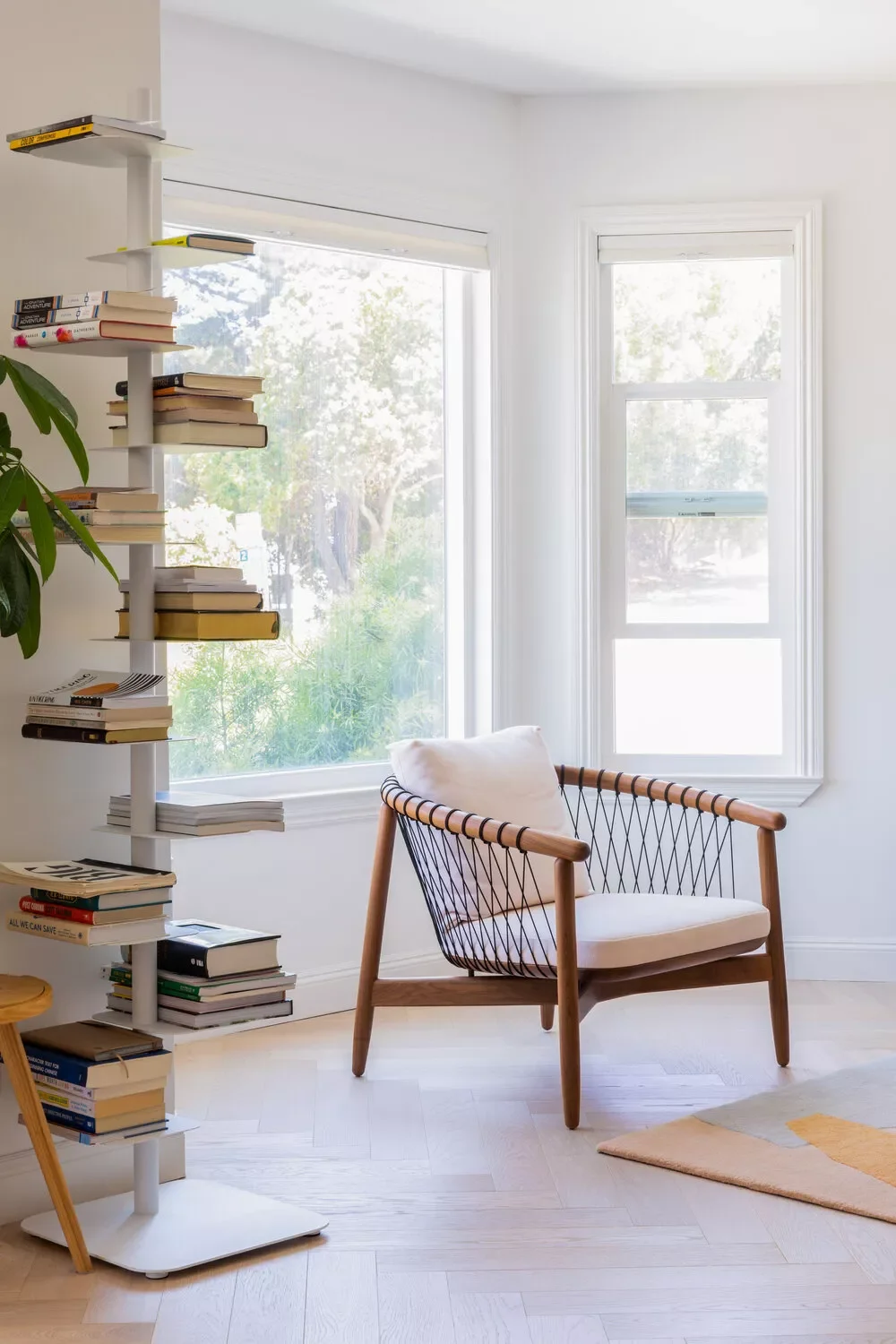
Credit: Design by Cathie Hong Interiors / Christy Q. Photography
You can save floor space while adding character by choosing vintage or unique storage pieces like standalone book towers.
These vertical solutions provide necessary storage without the bulk of traditional bookcases or built-ins. They also add personality and visual interest while maintaining the open feeling you need in small spaces.
47. Choose Smart Seating Solutions
You should select seating that fits your space perfectly while maximizing comfort without crowding your room.
Consider sectionals for maximum seating efficiency, or arrange comfortable armchairs around a central table. Add floor pillows and ottomans for flexible extra seating that can be stored away when not needed.
Final Thoughts
Your small living room has incredible potential when you apply these strategic design principles consistently throughout your space.
Remember that the key is choosing solutions that work together harmoniously rather than trying every trick at once.
Start with the ideas that resonate most with your lifestyle and personal style, then gradually incorporate additional elements as you discover what works best for your unique space.